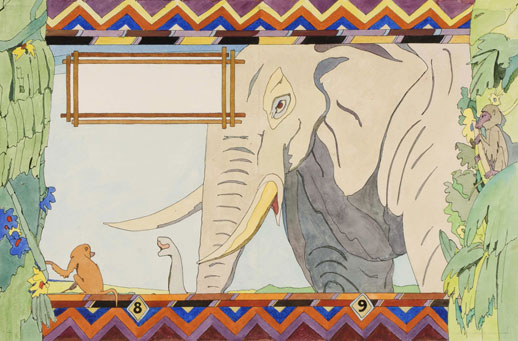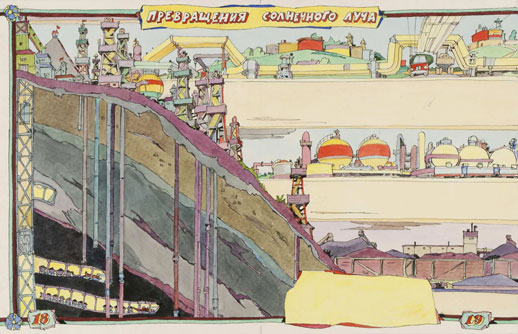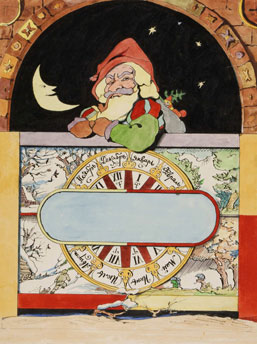Too Easy To Illustrate
Ilya Kabakov is best known as an internationally successful conceptual artist, whose pieces encourage particular experiences of memory, perception, or investigation in the minds of his viewers. He works primarily through large-scale installations, and Tokyo residents may have seen his work in a 2004 show at the Mori Arts Center, titled “Where Is Our Place?”

However, bar one exception that I will discuss later, this exhibition does not contain any of Kabakov’s conceptual work, but rather some of the many hundreds of children’s book illustrations he drew from 1956-1987, while employed as an “official” graphic artist, one of the few kinds of art activities sanctioned and rewarded by the Soviet government.
These illustrations are, graphically, not unusual for their time. I myself (born in the Soviet Union and emigrated at age 4) remember these sorts of children’s books, printed on coarse grey paper with elaborate illustrations and flourished typefaces, brought to me by my parents’ recent émigré friends or bought in Russian book shops in Brooklyn, still offering the smell of a place I barely remembered. The pictures were interchangeable. They were of girls in flouncy dresses with enormous bows in their hair, of wizened Russian grandmas with flowered kerchiefs, of roosters and foxes, of Puss-in-Boots, and of course, of machines: cars, airplanes, and locomotives, zooming through those story books, framed by endless smokestacks silhouetted against the cheerful post-industrial horizon.

Kabakov’s illustrations contain all the above and more. The Sun in Wire (1977), for example, is an instructional book showing how the sun’s energy is transformed. Kabakov draws sunning cows juxtaposed with the delicious sausages they will become, golden fields plowed by brightly colored tractors juxtaposed with fluffy bagels and bread loafs, or, on another page, a warm pool of light from an overhead lamp illuminating the school book of a studious boy.
Another learning book is The Wonders of Wood, a book cataloguing the endless variety of objects made possible by cutting down trees. Of course the imagery and subject matter of these books are embedded in their time: the promise of better living through industry, the fascination with transforming raw materials into energy, fuel, movement, and of course the Soviet Union’s ironclad grip on these images as their irrefutable corporate logos.
However, to me, even more interesting is the possibility that Kabakov himself, through his many illustrations of these kinds of books, was forced to think about how to, in very simple terms, explain the meaning of material life. What is the nature of wood? How do you communicate it graphically? The viewer of this exhibition can’t help but wonder how this type of question leaked off the “official” page containing the artists’s children’s drawings and onto those other pages (stuffed in the drawer) with his unofficial, private explorations.

In fact, the only interesting part of this exhibit is the possible relationship between these (at best) charming and (at worst) insipid drawings and Kabakov’s ‘real’ and sophisticated artwork, which he was making privately at the same time. Other than that, the viewer is relegated to the nostalgia of children’s books, or the graphic history of the USSR, neither of which necessitate Kabakov’s authorship over that of any Soviet illustrator.
Unfortunately, this kind of comparison is impossible for any but the most educated Kabakov-connoisseur, since none of his “private” artwork is hung side-by-side with his public drawings. In fact, the only non-official piece to be included in this show hangs in the final gallery. It is a series of pages from a coloring book. Each piece has a simple, repeated motif in bright colors (I remember butterflies in one, flowers in another). Behind the motif, in thin outline, are the words (I am translating approximately from the Russian) “Go Fuck Yourself”.
“Go Fuck Yourself,” as the only adult utterance in a field of baby talk, is the inevitable punchline. So, the only possible reading of the show becomes a standard story that we all know: The evil Soviet censors oppress and humiliate the heroic Artist who, finally, after undergoing the abuse a dog wouldn’t withstand, gets his day.
Of course, it is a true story, told by so many voices that the din extends from Israel to California. But, though the suffering of so many people never stops being important, that story can be told by anyone, and probably in a more convincing way than by Kabakov who, for all his real humiliation, passed over three opportunities to emigrate Russia before he finally left in 1988.
I am disappointed by the ‘Artist vs. State’ narrative of the exhibit. Had we been presented with a story of metamorphosis instead of a parable of power, we could have gleaned the flexibility of ideas, how they can move, acquire wings, grow teeth. This seems more apt for the contemporary political and economic world, where complicated networks of power have replaced despotic monoliths, and where almost everyone compromises daily in order to make work that is meaningful.
It is not to belittle the oppressions of the USSR when I say that we can relate to Kabakov as an artist with a day job. Seeing his public and private work side by side could have been a way for us to understand how our (increasingly necessary and yes, at times humiliating) day jobs as web designers, bartenders, computer programmers, kindergarten teachers, and advertisers inform the ideas that fuel the artwork which we make, as Kabakov put it simply, “for ourselves.”
Yelena Gluzman
Yelena Gluzman



